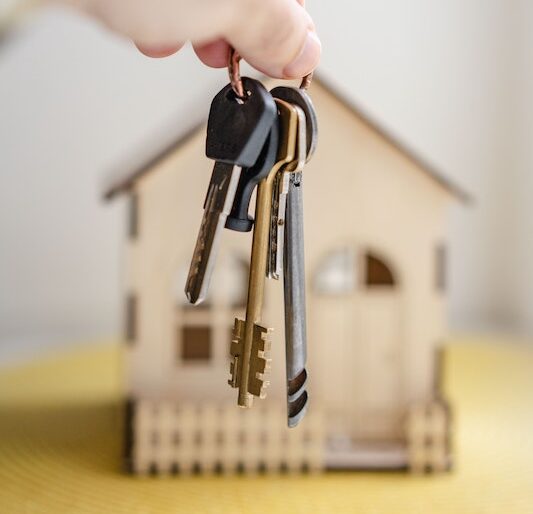
Entering the property market is a big and exciting decision, and every property investor has to start somewhere. Whether you’ve decided you want to become a landlord for some extra cash flow or you want to begin building your own property empire; getting a buy to let mortgage as a first-time landlord isn’t always easy.
Not every lender will offer buy to let mortgages for first-time landlords because of their lack of experience in the industry, and it is essential to understand the process and requirements before making an application. This expert guide covers all you need to know about buy to let mortgages for first-time landlords.
What is a buy to let mortgage for first-time landlords?

A buy to let mortgage works in a similar way to a regular mortgage. However, they are explicitly created for landlords who buy property to rent out to tenants. Buy to let mortgages are typically more difficult to obtain than a traditional mortgage as you need to prove you can cover the repayments even when you have no rental income.
First-time landlords can often struggle to show they can cover the costs involved and are seen by lenders as a riskier borrower because of their lack of experience. Being a first-time landlord and being a first-time buyer are two very different things that often get confused, it is vital to understand the differences when looking at your first buy to let mortgage:
First-time buyer
Each individual lender will have their own definition of what a first-time buyer is. Some lenders will say anyone who has never owned their own property before is a first-time buyer, whereas others may base their decision on how long ago a property was owned. For example, if you haven’t owned a property in the last five years.
First-time landlord
A first-time lender is generally defined as an individual who already owns their own home to live in but has never owned a residential property to rent out.
It is possible to be both a first-time buyer and a first-time landlord, however being approved for a buy to let mortgage without first having a residential mortgage is much more difficult and very few lenders will offer this. If you already own your own home, and now want to get a buy to let mortgage and become a first-time landlord, then you have much better chances of being approved by a lender.
Buy to let mortgages are explicitly designed for landlords to rent out the property to other tenants, if you are planning on living in the property yourself then it is a residential mortgage that you will need. Lenders are very careful to ensure that anyone with a buy to let mortgage is using it for the correct purpose, as historically they have been easier to obtain than residential mortgages, although this generally isn’t the case any longer.
Research the current buy to let market. As you are new to the market, it is essential to understand the risks and benefits of investing in property at any given time.
Why choose a buy to let mortgage?
Deciding whether or not to invest in property and become a first-time landlord is a big financial decision, and for individuals with enough money to raise a large deposit then it is often a profitable investment decision. As savings rates are currently reasonably low and the stock market continues to swing, the property market is currently bouncing back after its financial crisis and prompting more investors to make the most of rising property prices. London property prices have priced most investors out of the area. However, there are some areas in the UK that are yet to regain their losses after the financial slump. These are the areas that are building with popularity among investors and especially first-time landlords.
Like any investment, buy to let has no guarantees to make you money, but if the right property is found it can be very worthwhile. Be sure to properly research all your options and don’t make any hasty decisions.
How does a buy to let mortgage work for first-time landlords?
When you decide to buy a property to rent out and become a landlord, the chances are you will need a buy to let mortgage to fund the property purchase. Similar to a residential mortgage, the mortgage provider will lend you the money to purchase the property, and you will then make monthly repayments for the agreed duration.
With a buy to let mortgage, you are required to rent that property out to tenants, and that the rent you receive is usually more than the mortgage repayments. Most lenders will require that the rental income is 25-30% higher than the mortgage payments, and you will need to provide this information when applying. The mortgage repayments of a buy to let mortgage are required to be paid for the full duration of the mortgage, even if the property is vacant and no rental income is being received.
As a first-time landlord, it is essential to ensure that you can afford to cover the buy to let mortgage payments even if you have no tenants in the property.
A lot of buy to let mortgages are interest only, which means you pay nothing but interest each month and then at the end of the term pay the entire amount in full. Discuss your repayment options with your lender before committing to anything. Most buy to let mortgage lending is not regulated by the Financial Conduct Authority (FCA) although there are exceptions to this. If you are taking out a buy to let mortgage from an FCA authorised lender, they are required and expected to treat you fairly.
Before you start going out and choosing a property to buy, take the time to do the maths and work out exactly how much you are likely to get from a buy to let mortgage and how much rent you can get in the area you are looking in.
Who can get a buy to let mortgage?
As a first-time landlord, it can be difficult to get approved for a buy to let mortgage. Properly research and understand exactly what the requirements are for any given lender before making an application. Becoming a first-time landlord is a great way of getting some extra income, but getting a buy to let mortgage is also a great responsibility. Also see options for buy to let mortgages with bad credit.
To be approved, you will need to be able to prove to lenders that you can afford the repayments. Most lenders will require you to have a minimum of 25% of the property value as a deposit, and in some cases, the deposit could be as high as 40%, or 60% loan-to-value. This is much higher than with residential mortgages as first-time landlords are considered higher risk.
Income
A high deposit is not all you need to be approved for a buy to let mortgage; you will also need to have a certain minimum level of income and fit within the lender’s maximum age requirements. Individuals over the age of 70 will generally struggle to be approved for any type of mortgage due to their age and ability to pay it all off within their lifetime. Depending on the area you are looking to buy property in, you will need to meet a minimum level of income, which on average is £25,000 per annum. This number may vary depending on the location of the property and the value of the property.
Every lender has slightly different criteria for buy to let mortgages, however, in general, they are much more open to lending to first-time landlords today than they have been in the past. In some cases, you could be offered the same rates as an experienced landlord with a full property portfolio. However, some lenders see first-time landlords as very high risk and so will charge higher rates to protect themselves.
Being approved for a buy to let mortgage is as much to do with the type of property you want to buy as it is your personal financial situation. You need to find a property that will attract a continual stream of tenants and the right kind of tenants. Choosing a property in a remote location, or one that needs a lot of work, will be harder to secure a buy to let mortgage against than a well-located and good quality home.
Don’t make the mistake of assuming the property will always be let. You should still have a back-up plan for how the mortgage repayments will be made if you do not have a tenant in place.
How much do buy to let mortgages for first-time landlords cost?
As with any type of mortgage, the more money you can put down as a deposit, the better mortgage deal you could be offered. As a first-time landlord, the chances are lenders will ask for a high deposit to cover themselves, but if you can afford to pay more than the required amount, then you could end up paying less in the long run.
Rental coverage
Unlike a residential mortgage where the amount you can borrow is completely dependent on your salary and outgoings, buy to let mortgages are decided using the rental income that you could generate from a property. Typically, the rental income needs to be at least 125% of the monthly mortgage repayments. For example, if your mortgage is £750 a month, the rental amount should be roughly £1000.
The mortgage rates on buy to let’s vary a lot on the size of the deposit and the duration of the mortgage. For a two-year fixed mortgage with a high deposit, you could get a low mortgage rate of around 1.4%, whereas a 25% deposit will offer anywhere between 1.75% and 3% depending on the lender as of summer 2018.
Fees
Buy to let mortgages also come with hefty fees that should be looked into carefully before applying. In some cases, the fees charged can be as high as £2500 are much higher than with a residential mortgage.
Mortgage rates are currently at a record low, making it a great time to take those first steps on the buy to let property ladder. While these low rates are great for now, it is important to bear in mind that they must rise again one day, and you need to be sure that your investment can withstand this.
As well as rates that are sure to increase, there is also a tax rise being put in place, as buy to let mortgage interest relief is being axed and a 20% tax credit put in its place. In addition to this, since April 2016, landlords are now required to pay an additional 3% stamp duty on property purchases.
Remember to take into consideration that any rental income that exceeds your mortgage interest payments and allowable expenses are liable to income tax.
Changing a residential mortgage to a buy-to-let mortgage
If you have found yourself in a situation where you own your home but are planning to move out and want to keep the property, then you could consider renting it out to tenants. This is a common situation and one that must be dealt with properly. You must never move tenants into your property without formal and written permission from your current mortgage lender.
You will be required to change your current residential mortgage to a buy-to-let mortgage. Your current mortgage lender may be able to do this for you, which would permit you to move tenants in. Choosing this option can be the simplest, but also means you would then not be able to transfer your existing mortgage to your new residential property.
If your current lender won’t offer you a buy to let mortgage, or doesn’t provide a good enough deal, then you can shop around for a new buy to let mortgage for first-time landlords.
How to choose a buy to let mortgage for first-time landlords?
Walking into your local bank or building society and asking them for a buy to let mortgage might seem like the most straightforward and easiest option, but they will rarely be the best option. Contact a well rated, independent buy-to-let mortgage broker when you first start looking for your first buy to let mortgage. They will be able to help you understand all the deals available to you and can advise you which could be the best option for you and your situation.
An experienced broker will be able to share their knowledge with you and might even be able to offer some products you would never have thought about on your own. As well as discussing your first buy to let mortgage with a broker, you should also do your own research and build your own knowledge.
Most major banks, building societies and specialist lenders offer buy to let mortgages, but be sure to double check they do accept first-time landlords before spending time researching their products.
Comparison websites are always a good starting point as they can provide information on buy to let mortgages that are currently available and meet your specific needs. Thoroughly research the type of product and features you will need before going ahead with any one supplier, it always pays off to shop around.
Not all comparison websites will give you the same results, so be sure to look on a few different sites before making any decisions to make sure you really are getting the best deal.
Advantages of buy to let mortgages for first-time landlords
Deciding to become a landlord for the first time is a big, life-changing decision and it is essential to weigh up all the pros and cons of getting a buy to let mortgage as a first-time landlord. The main advantages of buy to let mortgages are:
Property makes for a great long-term investment
Property prices fluctuate all the time and vary greatly across the country; however, it is clear that the long-term trend is that property prices are on the up. Investing in a property now could pay off big time in a few years’ time.
Hassle free income
If you let a well-kept property to reliable tenants, being a first-time landlord can provide hassle-free income that comes in on a regular basis.
Release capital by selling
If you find yourself in a situation where you need to release some capital, you can sell your buy to let property. You may even be able to sell it at a higher price than what you initially paid.
Generation Rent is still growing
It is unlikely that there will be a shortage of people looking for private rented property in the medium to long-term. The number of individuals in Generation Rent that will never be able to afford to buy their own property is increasing, meaning more and more will be looking for buy to let homes.
Two income streams
One of the most significant advantages of investing in property and becoming a first-time landlord is that you can earn an income in two different ways. The first is through rental income paid by tenants, and the second is through capital growth.
As a buy to let investor, you have the same advantages as a first-time buyer when it comes to negotiating a deal. If you are buying a property as buy to let, then you are not part of a chain which can be a major asset when buying a home.
Disadvantages of buy to let mortgages for first-time landlords
As with any financial product, buy to let mortgages have their drawbacks as well as their benefits, and these should also be carefully considered before you decide if it is the right choice for you. The disadvantages of buy to let mortgages are:
A healthy housing market needs stability
For the property market to prosper, it needs stability, which is something that the UK lacks at the current point in time. With Brexit around the corner, it is an uncertain time for any market, including property.
Extra property tax
As of April 2016, if you are buying an additional property that is not replacing your main residence, then you are required to pay an additional 3% on your stamp duty bill. Unlike regular stamp duty, the extra 3% is charged at a flat rate on the cost of the property.
Tax relief caps
Tax relief available on mortgage interest has started to be capped at the basic rate of 20%. In the past, reliefs of 40% and 45% were available for high earners. This cap rollout started in April 2017 and by April 2020 will affect all landlords in the UK.
Properties require investment
Purchasing the property with the view to rent it out is one thing, but often in order to get it ready for letting you will need to invest more money.
Tenants can cause issues
Not all tenants that you rent your property to will be great community members and could cause issues and damage to the rental home. As a landlord, having these kinds of tenants in place can cause many problems.
Empty property means no income
One of the most significant risks of becoming a first-time landlord is that there will always be some periods where your property is vacant. This can cause cash flow problems as you will not be receiving a rental income but the buy to let mortgage will still need to be paid.
When choosing a buy to let property, consider your target tenant. Instead of thinking about whether you would like to live in your investment property, consider the situation of your target tenant. For example, if you want to rent to students, choose a property that is comfortable and easy to maintain.



